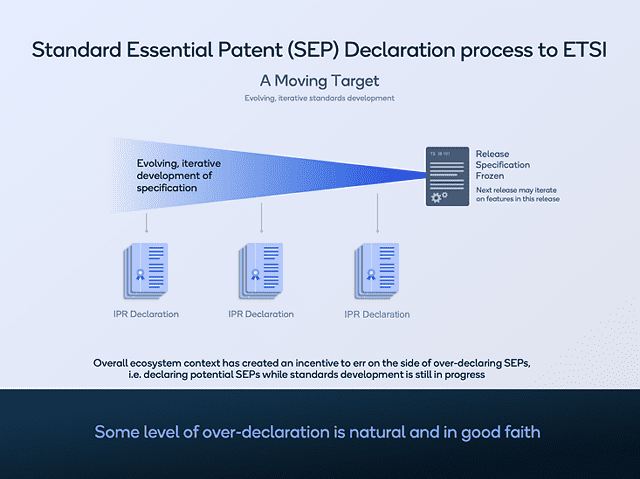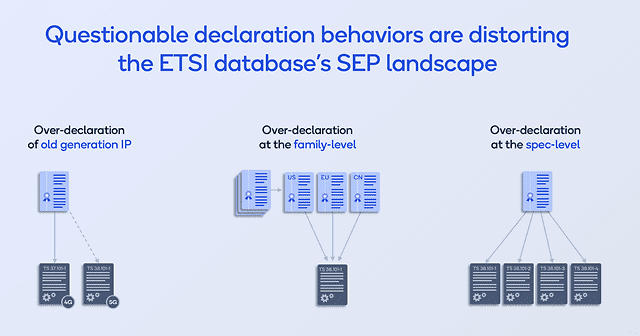How corporations alter perceptions of leadership in 5G by gaming the ETSI standard-essential patent database
The last piece stated that in order to comprehend leadership in the technical standard that defines 5G, it is vital to examine the underlying value of individual inventions and what they add to the standard. Only by examining these two elements can a complete, accurate image of 5G and the various building pieces that have contributed to its development be obtained. Approaches that rely exclusively on fundamental criteria, such as calculating the number of contributions made by individual participants, disregard the wide range of inventions present across the whole 5G technological tree.
For this, several studies continue to attempt to establish 5G leadership using a variety of quantitative indicators. The European Telecommunication Standards Institute (ETSI) 5G standard-essential patent (SEP) database is one of the most frequently used sources they use. I’ll go into more detail about the specific reasons why this strategy in particular is inherently problematic in this blog.
Standards are cooperative frameworks for creating practical technological solutions.Thousands of engineers from around the world come together to discuss current technical challenges, present available solutions, and choose the best technology options based on technical merit to create technology standards like 5G through voluntary collaboration among sector-leading companies.
Companies are invited to voluntarily disclose what intellectual property rights (IPRs) they own in connection with important technologies that are or may become fundamental to the standard as part of the 5G standard, in addition to taking part in this exchange of ideas. The ETSI’s IPR database, which provides a public repository of the disclosures, receives declarations.
ETSI does not filter, confirm essentiality, or do other analysis of what is declared and put into the database.
It is clear that some degree of error is inherent in these disclosures given the nature of the standards process. The standard is a shifting target until it is finalised since everything is being suggested, discussed, and contested in real time as the specifications iterate and change rapidly.
This implies that when the standard develops and takes on new forms over time, the submitted ideas and any accompanying intellectual property (IP) may lose their applicability. It is important to note that ETSI does not offer a method to retract a declaration in the event that a patent subsequently ceases to be relevant to the 5G standard.
As a “natural” by product of the process, this leads to some degree of over-declaration that is made in good faith with the intention of transparency for the future.
Where did the 5G foundations originate?
However, a number of IP analytics companies have recently started utilising the ETSI database’s raw IPR disclosure figures as their main method for identifying 5G leadership.
Simple logic dictates that a corporation must be more significant to the overall standard the more 5G SEPs it has declared. Companies are increasingly motivated to increase their disclosure numbers in the ETSI database as a result of the popularity of this and other quantitative approaches. Some businesses, eager to enhance their perceptions of leadership, have recently started purposefully inflating their 5G IPR contributions in a number of ways.
SEPs turns are being intentionally inflated using dubious methods.
In this section we will specifically draw attention to three dubious declaring practises that “game” these reports and alter the SEP landscape in the ETSI database:
the excessive declaration of unrelated IPRs
This occurs when one or more patents that are obviously unrelated to 5G are revealed as being crucial to the 5G standard. Despite falling behind in 5G innovation, several businesses that were big 4G developers have simply declared that practically all of their old 4G patents are applicable to the new 5G standard, regardless of whether or not those technologies were included in the new 5G standards.
As a result, the related IPRs apply to both 4G and 5G. It is true that several features developed for 4G are vital to how current cellular communications operate and are, thus, fundamental in 5G. The orthogonal frequency-division multiplexing (OFDM)-based waveform design that serves as the foundation of over-the-air transmission for both systems is a fantastic illustration of this, as our own 5G leadership blog explains. However, some 4G characteristics do not transfer to 5G, and such IPRs should not be included in the ETSI database as fundamental to 5G since they are irrelevant to the new 5G standard.
It greatly overstates a company’s real technological contributions to the standard to declare all 4G patents to be 5G-compatible.
family-level over-declaration
Patents are property rights, but the organisations that award them (such as the USPTO in the US, the EPO in Europe, the CNIPA in China, etc.) are innately territorial. Companies that conduct business internationally must patent the same innovation in many jurisdictions in order to ensure that their inventions are protected internationally. A “patent family” is the outcome of the same or a comparable innovation being granted several patents in numerous jurisdictions.
This is taken into consideration by ETSI’s IPR Policy, which promotes just one patent from a patent family to be designated as being important to the standard. Therefore, a corporation normally selects one patent from this family, the so-called “basis patent,” to submit to the standard.
But recently, several businesses have adopted the strategy of independently declaring numerous patents from the same family (and, in essence, the same innovation), to the 5G standard. As a result, their numbers of “basis” standard-essential patents rise, but this plainly doesn’t mean that the corporation has made more inventions that have contributed to the standard. The number of “basis” patents is still a criteria that some IP research companies use to assess 5G leadership, nevertheless.
At the 3GPP standard level, there are hundreds of separate technical specifications for 5G, each of which describes a different component of the technology. It is improbable that the same innovation applies to a dozen technical standards, each concentrating on a very specialised area, even while it may apply to a few specifications (for example, lower-layer aspects and upper-layer aspects). However, it is now standard practise for certain businesses to disclose one copyrighted idea as being crucial to a number of various criteria.
A single patent is listed as being necessary to 17 separate requirements in the sample below, which is derived from the ETSI forms that are open to the general public. When examined closely, these standards come from various working groups that have completely different definitions.
It should be noted that certain IP analytics companies provide charts with SEP numbers for every single standard. When that occurs, declaring the same SEP to several distinct specifications may lead to that SEP being tallied twice, three times, four times, or even more in those counting exercises. This obviously creates a false impression of the true number of SEPs that a certain organisation has.
superiority of quality over quantity
Achieving more openness and identifying actual leaders
These deceptive declaring practises skew perceptions of true leadership in 5G and increase the number of SEPs in the ETSI database. This is a regrettable by product of the openness and transparency of the ETSI IPR process, a method based on good faith self-declarations designed to make it simpler for everyone to identify what IPRs may apply to the cellular standards and never meant to be a criterion to assess standard leadership.
Unfortunately, IP analytics companies still rely on this data to draw inferences about 5G technology and IP leadership. In addition to the mainstream media, policymakers frequently employ these fundamentally inaccurate findings in their examination of the standards environment.
One cannot just count how many pieces of paper they own to comprehend genuine worth, just as a $100 note is more valuable than a $1 bill. Although simple to comprehend, shortcut counting techniques don’t offer a reliable way to identify leadership.
The difficulties in determining 5G leadership using the ETSI database have been noted by regulators as well as industry participants. For instance, a section regarding a different IP disclosure database is included in the most recent proposed SEP legislation from the European Commission with the aim of increasing openness. In order to achieve this aim, Qualcomm actively collaborates with industry partners both inside and outside of ETSI. Qualcomm supports initiatives to promote transparency.
As we have demonstrated, counting declarations in the ETSI database is not a reliable means to identify leadership, especially given how easily they may be “gamed” in the methods mentioned above. The single most significant component in 5G leadership continues to be the quality of inventions.





[…] consumer experience for data services like streaming, gaming, and social media by utilizing their 5G network and the strength of AIOps. In-depth discussion of Three UK’s use of Azure Operator Insights to […]
[…] MWC Las Vegas, 5G becomes a […]